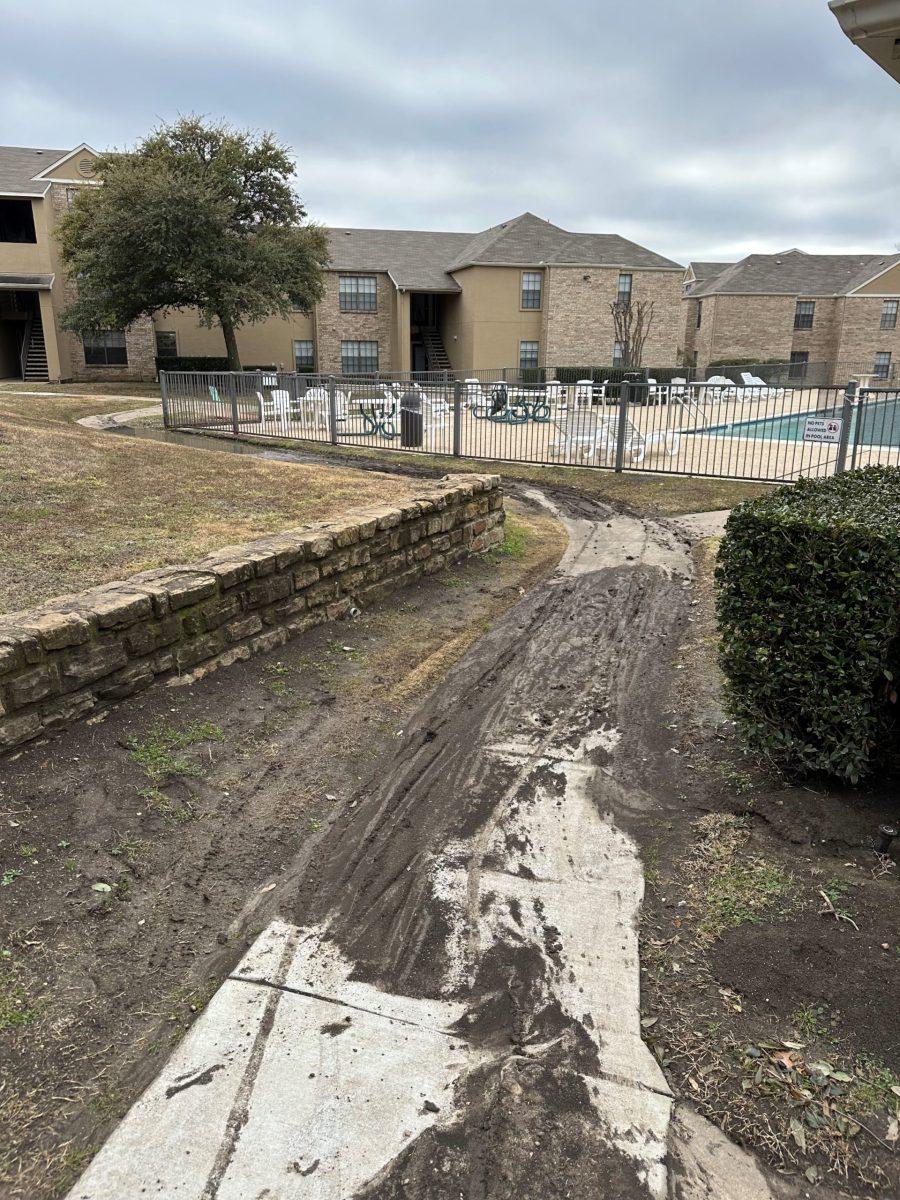Any resident of UV knows that after a rainstorm, it’s best to take the long way around and avoid the sidewalks. Whenever there is even a small amount of rainfall, housing areas become impassable quagmires full of water and mud — but does it have to be that way?
University Village’s foundational issues with the layout of student apartments leads to chronic flooding in key walkways, a continuous inconvenience to students trying to get to and from class. It’s become typical for there to be inches of wet mud and pools of water occupying much of the sidewalk, especially in older phases like 2 and 3. These obstructions often take days for the administration to fix, requiring maintenance workers to clear out the buildup of muck across UV after every single storm, which until then blocks students’ paths and makes it difficult for people with accessibility needs to navigate campus. UTD desperately needs to invest in either better stormwater management or a landscape that is less conducive to flooding.
UV’s drainage problems stem from its age, as the oldest phases were built in 1989. These 35-year-old apartments have not aged well, as we’ve seen a degradation of walkways with steep hills and recesses resulting in systemic issues with flooding. Some walkways have wooden platforms installed into the sidewalk in an attempt to counteract the movement of mud and water, but the small channels they provide to help drainage have not been very effective.
As UTD’s campus rapidly expands with new buildings like the new Student Union and the Athenaeum, this increased construction must be accompanied by an expansion in the infrastructure that manages stormwater. UT Austin Assistant Professor of Community and Regional Planning Katherine Lieberknecht said cities and areas which experience rapid growth regularly struggle with stormwater infrastructure. This issue is particularly bad in UV because of its age. While UV apartments were expanded from 1989 to 2005, it is likely that the stormwater systems were not satisfactorily expanded to match the new construction and runoff from concrete, which could lead to increased pooling in older phases of UV. This problem will only get worse as climate change intensifies earth’s water cycle, leading to heavier rain.
“There are definitely things that UT Dallas can think about doing, and some of them are pretty low intervention,” Lieberknecht said. “Just making space for that rainwater to infiltrate into the ground more quickly … you can do that in ways that actually have other benefits too.”
An effective way to mitigate flooding would be to simply provide more space for rainwater to soak into the ground, to speed up drainage. This could be done by digging up concrete fixtures and adding in more greenspace or a garden. A prime candidate for this would be the pools around UV: these fantastic wastes of money see little to no student use and generally obstruct walking paths around the apartment structures. Certainly they were originally made with good intentions, but seeing as they rarely see any activity, they would be prime candidates for removal.
While removing the pools could help with water pooling, it would also impair student movement for a time, as large areas in almost every phase would need to be closed off for construction. As a lower impact fix, the university could make minor landscaping changes to the terrain around UV, like evening out parts of walkways with steep hills.
Ultimately, it would seem that UTD is not very invested in improving its aging apartments as it struggles to just meet demand for housing, with a waitlist that gets longer year by year. Shy of knocking down structures and completely redoing the land UV is built on, the only feasible way to fix this issue would be to significantly change its landscaping. Unfortunately, extensive changes to landscaping would be costly, meaning admin will not want to implement them on their own. If we want to improve flooding on campus, we will have to do it ourselves.
In the past, advocacy for change around campus has been successfully pushed in student council meetings. SG’s Residential Student Affairs Committee is responsible for making “living on campus the best that it can be,” according to their website, and is a prime target for concerns about the infrastructure of housing. So if you are tired of wading through a puddle of mud after every little rainstorm, please, join me in emailing your concerns to the current committee chair, Anish Padala.






